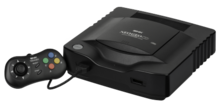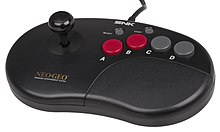Neo Geo CD
 | |
 The top loading Neo Geo CD system with controller | |
| Manufacturer | SNK |
|---|---|
| Type | Home video game console |
| Generation | Fifth |
| Release date | |
| Introductory price | |
| Discontinued | 1997 |
| Media | CD-ROM |
| CPU | Motorola 68000 @ 12 MHz |
| Predecessor | Neo Geo AES |
The Neo Geo CD (ネオジオCD, Neo Jio Shī Dī) is a home video game console produced by SNK Corporation, released on September 9, 1994. The system is the same platform as the cartridge-based Neo Geo released four years earlier, but converted to the cheaper CD media format which retailed at $49 to 79 per title compared to over $200 for the equivalent cartridge.[1]
The Neo Geo CD was launched with a bundled control pad instead of a joystick like the AES version of the Neo Geo came with; however, the system was compatible with controllers from the AES. The Neo Geo CD had met with limited success due to it being plagued with slow loading times that could vary from 30 to 60 seconds between loads, depending on the game. As of September 30, 1997, there had been 570,000 Neo Geo CD units sold worldwide;[2] production of all Neo Geo hardware was discontinued in 1997, while new software continued to be released until 2004.
History
[edit]
The Neo Geo CD was first unveiled at the 1994 Tokyo Toy Show.[3] The console uses the same CPU set-up as the arcade and cartridge-based Neo Geo systems, facilitating conversions. SNK planned to release Neo Geo CD versions of every Neo Geo game still in the arcades.[4]
Three versions of the Neo Geo CD were released:
- A tray-loading Japan-only version, colloquially known as the "front loader"
- A top-loading version global version, colloquially known as the "top loader"
- A double-speed unit, a Japan-only upgraded, faster-loading version
The front loader is the original console design, while the top loader version was developed shortly before the Neo Geo CD launch as a smaller, cheaper alternative model.[5]
All three versions of the system have no region lock, but they are region aware, and some games will display English or Japanese depending on the console's region setting. The system can also play Audio CDs.
The system itself was originally priced at US$399.[6] Approximately one month after launch, SNK reported that they had sold the Neo Geo CD's entire initial shipment of 50,000 units.[7]
Criticism of the system's generally long loading times began even before launch; a report in Electronic Gaming Monthly on the Neo Geo CD's unveiling noted, "At the show, they were showing a demo of Fatal Fury 2. The prototype of the machine that they showed was single speed, and the load time was 14-28 seconds between rounds. You can see that the screen[shot] on the right is a load screen."[3]
In response to criticism of the Neo Geo CD's long load times, SNK planned to produce a model with a double speed CD-ROM drive for North America, compared to the single speed drive of the Japanese and European models.[1] However, the system missed its planned North American launch date of October 1995, and while SNK declined to give a specific reason for the delay,[8] in their announcement of the new January 1996 launch date they stated that they had decided against using a double speed drive.[9] Their Japanese division had produced an excess number of single speed units and found that modifying these units to double speed was more expensive than they had initially thought, so SNK opted to sell them as they were, postponing production of a double speed model until they had sold off the stock of single speed units.[10]

The CDZ was released on December 29, 1995[11][12] as the Japanese market replacement for SNK's previous efforts (the "front loader" and the "top loader").
The CDZ was only officially sold in Japan during its production; however, its faster loading times made it a desirable import for enthusiasts in both Europe and North America.[citation needed] The system's technical specs are identical to the previous models except that it includes a double-speed CD-ROM drive,[13][14] and different CD controller circuitry.[15]
Reviewing the Neo Geo CD in late 1995, Next Generation noted SNK's reputation for fun games but argued that their failure to upgrade the Neo Geo system with 3D capabilities would keep them from producing any truly "cutting edge" games, and limit the console to the same small cult following as the Neo Geo AES system although with less expensive games. They gave it 1 1/2 out of 5 stars.[16]
In response to reader inquiries about Neo Geo CD software, GamePro reported in an issue cover dated May 1997 that SNK had quietly discontinued the console by this time.[17] It was also the last home console produced by SNK.
Technical specifications
[edit]
- Main Processor: Motorola 68000 running at 12 MHz. Although the original CPU was designed by Motorola, many of the 68000 CPUs in Neo Geo hardware are manufactured by second-sources. The most common CPU is the TMP68HC000 manufactured by Toshiba.[citation needed]
- Coprocessor: Zilog Z80 running at 4 MHz
- Colors on screen: 4,096
- Colors available: 65,536
- Resolution: 304 x 224
- Max sprites: 384
- Max sprite size: 16 x 512
- Number of planes: 3 (128 sprites per plane as the Neo Geo does not use tiles for its planes like with most game systems at the time)
The system is also capable of reading Redbook standard compact disc audio.
In addition to the multi-AV port (nearly identical to the one used on the Sega Genesis model 1, though they are not interchangeable), all Neo Geo CD models had composite RCA A/V and S-Video out jacks on the rear of the console.
The CD system's 56 Mbit / 7 MB of RAM[1] was split accordingly:
- 68000 program memory: 2 MB
- Fix layer memory: 128 KB
- Graphics memory: 4 MB
- Sound sample memory: 1 MB
- Z80 program memory: 64 kB
- VRAM: 512Kb[4] (For graphics attributes)
- SRAM: 2 KB (For high scores / general save data)
Software
[edit]
While the Neo Geo CD library consists primarily of ports of MVS and AES titles, there are a few MVS arcade games which were not officially released for the Neo Geo AES and ported instead to the Neo Geo CD. These include Puzzle Bobble, Janshin Densetsu: Quest of Jongmaster (a Mahjong game also released for the PC Engine), Power Spikes II, Neo Drift Out: New Technology, and Pleasure Goal: 5 on 5 Mini Soccer (Futsal: 5-on-5 Mini Soccer).
A few games which were unreleased in MVS and AES formats were also released exclusively for the Neo Geo CD. These include Ironclad: Tesshō Rusha (Chōtetsu Burikingā, BRIKIN'GER), Crossed Swords II, ZinTrick (Oshidashi Zintorikku), ADK World, Neo Geo CD Special, The King of Fighters '96 Neo Collection, Samurai Shodown RPG (Shinsetsu Samurai Spirits: Bushidō Retsuden; an RPG spin-off of the Samurai Shodown series that was also released for the Sony PlayStation and Sega Saturn), and Idol-Mahjong Final Romance 2 (an arcade game which is not an MVS game, but was ported directly to the Neo Geo CD).
Two prototype games were in development: Bang² Busters [Bang Bang Busters] (Made by Visco in 2000. Released in 2010 for Neo Geo CD by N.C.I.) and Treasure of the Caribbean [Caribe no Zaihō] (Made by Face in 1994. Released in 2011 for Neo Geo CD by N.C.I./Le Cortex).
References
[edit]- ^ a b c "Neo Geo CD: The New Kid in Town". GamePro. No. 85. IDG. October 1995. p. 30.
- ^ "Japon Previews: Tokyorama - Les Ventes De L'année". Consoles + (in French). No. 73. M.E.R.7. February 1998. p. 47.
- ^ a b "Neo Geo CD Brings Arcade Home". Electronic Gaming Monthly. No. 61. Sendai Publishing. August 1994. p. 60.
- ^ a b "The Neo Geo CD: An Arcade in Your Home". GamePro. No. 79. IDG. April 1995. p. 16.
- ^ "SNK CD for Spring". Electronic Gaming Monthly. No. 63. Sendai Publishing. October 1994. p. 62.
- ^ "Neo Geo CD to Debut in October". GamePro. No. 84. IDG. September 1995. p. 138.
- ^ "Gaming Gossip". Electronic Gaming Monthly. No. 65. Ziff Davis. December 1994. p. 56.
- ^ "Neo-Geo CD Delayed". GamePro. No. 88. IDG. January 1996. p. 22.
- ^ "Neo Geo CD Back on Track". GamePro. No. 89. IDG. February 1996. p. 16.
- ^ "Neo CD to Be Single Speed". Electronic Gaming Monthly. No. 79. Sendai Publishing. February 1996. p. 20.
- ^ "Neo Geo CD World" (in French). Archived from the original on December 17, 2010. Retrieved December 11, 2015.
- ^ http://www.obsolete-tears.com/snk-neogeo-cd-machine-226.html (in French)
- ^ "SNK Brings Out New Neo CDX". Electronic Gaming Monthly. No. 80. Sendai Publishing. March 1996. pp. 16–17.
- ^ "Neo Geo Short Stories". Maximum: The Video Game Magazine. No. 3. Emap International Limited. January 1996. p. 117.
- ^ "Neo Geo CDZ". Retro Gamer. 232: 62. May 2022. Retrieved May 21, 2022.
- ^ "Which Game System is the Best!?". Next Generation. No. 12. Imagine Media. December 1995. p. 75.
- ^ "Survival of the Coolest". GamePro. No. 104. IDG. May 1997. p. 16.
